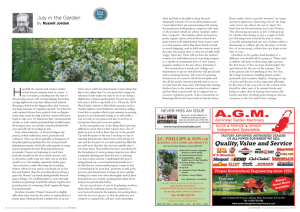
Hopefully the warmer and sunnier weather in June has put summer back on course. A very wet winter, extending into the start of the growing season, with correspondingly lower than average light levels, may have delayed and reduced flowering a little but the biggest effect that I noticed was huge amounts of vegetative growth. Now that the early summer blooms have peaked, often on floppier stems than usual, the high and later summer bloomers begin to take over. My heleniums that I mentioned last month, as a late summer perennial that actually begins flowering in June, are actually somewhat behind this year and will only be peaking in July.
Some other mainstays, of this post longest day period, include rudbeckias, asters, persicaria and echinacea. These are all recognisable as being part of the plant palette popularised by the ‘new perennial’ planting movement, which also relies greatly on using grasses alongside the later flowering herbaceous perennials. Grasses are beginning to reach their peak this month but the most stately species, such as Miscanthus, really come into their own in another month or so. The smaller, supremely frothy, grass Stipa tenuissima is earlier flowering but is turning buttery yellow by now and its seed heads are no less fine and feathery than the preceding flowers (being a grass the ‘flowers’ are barely distinguishable from its grassy foliage). It’s a brilliant plant to weave through herbaceous plantings to hold the scheme together and provide pools of contrasting ‘froth’ against the larger leaved perennials.
Sporobolus heterolepis (‘Prairie Dropseed’) is slightly taller than Stipa tenuissima but often recommended as a prairie grass which performs a similar role, as an airy foil to more ‘solid’ leaved perennials. I must admit that this is not a plant that I’ve ever grown but seeing it in reference books makes me want to try it out. Being a slightly less common garden plant, I’m not sure quite how easy it will be to get hold of it—I’ll use the ‘RHS Plant Finder’ website to find which nurseries stock it. ‘Knoll Gardens’, near Wimborne, are listed as selling it and this is a garden which is pre-eminent in growing grasses, in an ornamental setting, so is well worth a visit not only to buy grasses but also to see how to incorporate them into your own garden.
In my own garden one of the things that is proving difficult in recent times is that I always have a lot of plants in pots as well as those that are ‘in the ground’. Up until this point of the year I can keep on top of watering them because there’s been a fair amount of rain and also because it’s not until a plant has filled the pot with roots that they dry out more quickly than I can water them. The problem has been exacerbated by the formulation of most potting composts now either completely deleting peat from the mix or reducing it to just a token amount. I understand why peat is being phased out, on environmental grounds, but I do find that no current multi-purpose compost, that is formulated to be ‘peat-free’, performs as well as the previous peat-based mixes. Drying out more quickly, holding less water even when thoroughly wetted, these formulations are certainly causing greater plant losses and poorer growth than before.
It’s not a good time of year to be planting out these plants that are suffering in pots, this operation is now best performed in the autumn, but potting them onto the next size up pot, so that the plant has new compost to expand into, will give some immediate relief and help in the fight to keep the pots adequately watered. It’s not an ideal situation and I must admit that I am experimenting with mixing the proprietary multi-purpose composts with some of the products which are sold as ‘mulches’ rather than ‘composts’. The mulches which are based on purely organic matter, derived from rotted down plant matter, with added humus from sources such as rotted manure, rather than those based on bark or wood chippings, tend to hold onto water in much the same way as peat does i.e. they are actually really ‘soggy’ when wet. These will not have the nutrient content of a well balanced seed or potting compost so I add the recommended dose of slow release, granular, fertiliser to the mix when I formulate it.
This month there is mostly just ‘ticking over’ maintenance to get on with plus the odd special task such as pruning wisteria. The reason for pruning wisteria now is to remove the flowered spikes and also all the unruly extension growth back to six or so buds from the main stem. This keeps this twining climber close to the structure on which it is trained and less likely to peel itself off its support due to excessive vegetative growth. It also concentrates its flowering efforts into fewer buds so that the future flower spikes (more correctly ‘racemes’) are larger and more impressive. Removing a lot of the long, outer, leaves also allows the sun to ‘ripen’ the buds that are left and initiate next year’s flowers. This shortening operation in July is followed up by a further shortening, to just a couple of buds per flowering stem, towards the end of winter. Generally trimming back any sort of plant which is threatening to collapse all over the place, or break free of its moorings, seldom does any harm at this time of year.
Elsewhere in the garden dead-heading of a different sort should still be going on. Plants such as dahlias will keep on flowering, right up until the first frosts, if they are kept dead-headed, fed and watered for the rest of the summer. This is the general rule for anything of the ‘live fast, die young’ persuasion; bedding plants, tender perennials and container displays. Keeping on top of pests and diseases is also important although, by this time of the year, a lot of the control work should be taken care of by natural checks and balances rather than by human intervention; lily beetles and their revolting grubs being an obvious exception to the ‘live and let live’ strategy.




